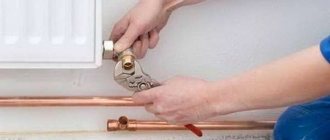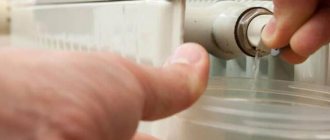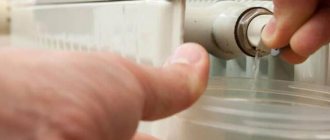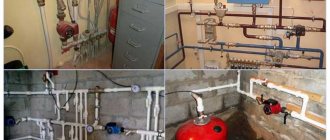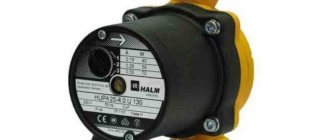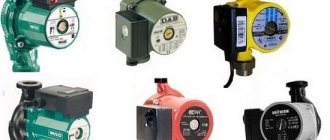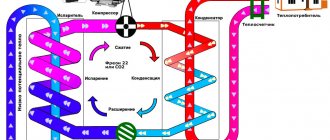If the heating system of a private home is filled with water or antifreeze, then air accumulations may occur in it for various reasons. They appear in different places and interfere with the normal circulation of the coolant, which leads to the cooling of both individual radiators and entire risers. It is clear that air should not be in the heating system and must be removed in one way or another. The purpose of this article is to identify the causes of air jams in the pipeline network and talk about how to “drive them out” into the atmosphere.
Little things and nuances
If, when installing the heating system, the craftsmen were lazy and did not install a special valve on the heating radiator, then you yourself will have to carry out the simple procedure of bleeding air from the battery, but in a slightly different way.
To do this, you need to have a gas or adjustable wrench with you, with which you begin to very slowly unscrew the plug. If the screw cap on a cast iron battery does not come off, apply thread lubricant directly to the thread itself and try again after a certain time.
In private houses with an autonomous heating system, it is sometimes necessary to drain the water using an expansion tank, which is always located at the highest point of the heating system.
After the water has been drained, wait a while and then unscrew the tap on the expansion tank. Almost always the plug comes out on its own when the radiator temperature rises. If these actions do not lead to the desired result, bring the water in the heating system to a boil and then the air lock will definitely come out.
Also keep in mind that an air lock can form in places where the pipeline is bent; for this reason, when installing a heating system, it is necessary to maintain the optimal distance for the direction of slopes when laying out the pipeline.
If the actual slope of the pipe differs from the designed one or the pipeline makes a loop, then it is necessary to install additional air bleed valves.
Modern manufacturers of heating radiators are sometimes not very conscientious in their production, and as a result, we receive a low-quality radiator, which can bring additional headaches. And all because, no matter how much you bleed the air from a battery that is not made according to standards, the air in it will be endless. Because the radiator material itself promotes the formation of gases. There is only one solution to this problem - buy a new high-quality battery.
If you prefer the video instruction format, watch the video below. Everything is shown there step by step.
We hope that the material was useful to you. Please click on the social media buttons below.
I wish you a warm home and no air-filled radiators!
Often, in the first days after the heating system starts operating, it is discovered that some batteries are not working at full capacity. The reason for this may be airiness of the elements. Solving this problem in apartment buildings is the task of housing office workers. But they don’t always do it in good faith. And in private households, troubleshooting falls entirely on the shoulders of the owners. Let's look at how to bleed air from the battery yourself.
Before we figure out how to bleed air from the heating system, let's figure out why it accumulates there. Main reasons:
- carrying out repair work - during disassembly/assembly of elements, air inevitably enters them;
- improper start-up of the heating system in an apartment building - according to the standards, the pipes must be filled with water slowly while simultaneously bleeding out excess air;
- loose fit of parts of the system or poor sealing of joints - the coolant flows out imperceptibly and evaporates, and air is drawn in from outside;
- low pressure in the pipeline, leading to the formation of voids and their filling with air;
- increased amount of oxygen in the coolant - there are always gas bubbles in the water, but if there are too many of them, air pockets can form;
- incorrect connection of the underfloor heating system - arrangement of branches at different heights;
- incorrect operation or absence of an air vent on the battery.
In addition, poor quality radiators can lead to air accumulation. They are distinguished by their affordable price and high thermal conductivity. But the metal actively reacts with water, resulting in the release of hydrogen gas. The problem of rapid corrosion is partially solved by a film that covers the inside of aluminum, but it disappears over time. A more reliable, durable and expensive option is bimetallic batteries, which combine aluminum with steel that is resistant to water.
As a rule, residents of the top floors of apartment buildings face the problem of how to ventilate batteries. When heated, oxygen dissolved in water rises, forming plugs. In private houses with an open heating system, air bubbles freely exit through the expansion tank at the top of the system, so air usually does not accumulate, except in some cases.
How to prevent airing
Air vents can be installed to prevent air pollution. They must be installed in pipe bends or at high points where pipelines are located.
You can also fill the equipment with water. During the process of filling with water, it is necessary to open all taps except those that drain water. Water is supplied from bottom to top. When carrying out such actions, water squeezes air out of the system. But do not forget that water should be supplied slowly. Once water starts flowing from the tap, it must be turned off. Thus, the water will continue to rise higher until the entire system is full.
What is an airy battery and how to determine it
If you notice that the batteries do not heat up at full capacity, although just yesterday the entire system worked perfectly and the house was warm, the problem is probably that you just need to bleed the air from the battery that is not quite hot. This article will tell you in detail how to bleed air from a battery.
Before bleeding air, you need to make sure that this is really the cause of the system failure.
First, check all the batteries: if they are all too cold or, on the contrary, too hot, the problem may be directly in the heater or perhaps other sediment has accumulated in the batteries. Also check to see if water is dripping from the batteries. There may be a leak in the battery, then you just need to turn off the heating system and.
If the situation does not change as a result of the actions taken, the nut may be corroded and needs to be replaced. There are times when the radiators on the upper floors remain cold, while on the floor below the radiators are very well heated. In such cases, it is advisable to call a master who specializes in this field.
And if, as a result of a detailed examination of the heating system, you have not found any other problems, except that some battery is partially or completely cold, then you just need to understand how to bleed the air from the battery.
What can an airy heating system lead to?
But first, let's figure out what the consequences may be from such a seemingly harmless airiness of one battery.
As it turned out, the fact that the radiator does not heat the room is not the biggest problem. The main problem is that air in the batteries leads to rusting from the inside, and as a result, a decrease in the service life of the heating radiator.
The next nuance is that if you have an autonomous heating system, then the boiler is forced to “drive” air through the system, not liquid. And this leads to premature damage to the bearings on the shaft and, as a result, the pump fails in advance.
How to properly bleed air from a battery?
Useful diagram for work
In order to release air from the heating battery, use a special key that can be used to open the “air valve”.
Most often, in such cases, a special radiator wrench is used, which can be purchased at a hardware store. Modern batteries allow you to use a screwdriver for such purposes.
Now that you have a key or a screwdriver, as well as a container for draining water, at hand, inspect the battery and on any side of it, find a small valve, which is popularly called the Mayevsky tap.
Today you can install several such valves, or you can get by with just one, in the upper part of the radiator. When you have found the valve you need, unscrew it to the side until you hear air hissing.
Place a container under the tap and wait until all the excess air comes out and water begins to drip. Wait until the water stops bubbling and runs in a thin stream. Now all the air in the batteries has been drained, and the tap can be screwed back to its original position.
In addition to the above-mentioned Mayevsky tap, an automated air bleeder or a regular valve can be installed on the heating radiator, which is simply screwed into one of the upper radiator plugs. The automated bleeder will spontaneously perform all actions to bleed excess air from the battery.
Blowing out the gas valve
If you did everything correctly, you will see a gas valve in front of you and a connector on it, marked with a red circle - a place for introducing air.
Do not try to insert the needle! You can easily puncture the valve, at which point it will need to be replaced.
In addition, the connector is very small: the needle may not pass through. To blow, draw air into the syringe, press the nozzle tightly against the hole and let the air in. If the operation occurs without sound or resistance, the connection is not tight. When the task is completed correctly, you will hear a slight hissing sound.
That's all. Now you can check the result, for example, by turning on the hot water. If the fire lights up, you will hear it. The corresponding icon will also appear on the display, and warm water will flow from the tap.
Be careful: at first the water that was in the pipes will flow out of the tap, and only a little later - the heated water.
Assemble the boiler according to the same procedure that was used during disassembly: secure the display, and then the lid. It is worth installing it in place from top to bottom.
Blowing out a gas valve is not an uncommon task. If you learn how to do it quickly and efficiently, you will save a lot of effort and time.
What is an airy battery and how to determine it
If you see that the batteries are not heating up to full capacity, even though just yesterday the whole system worked perfectly and the house was warm, as if the whole difficulty is that you just need to bleed the air from the battery that is not very hot. This article will tell you in detail how to bleed air from a battery.
Before you bleed air, make sure that it is actually considered to be the cause of the system failure.
First, you need to check all the batteries: if they are all too cold or, on the contrary, too hot, the problem may be specifically in the heater, or perhaps other sediment has collected in the batteries. Also check to see if water is dripping from the batteries. There may be a leak in the battery, then you just need to turn off the heating system and tighten the nut on the battery inlet valve.
If the situation has not changed as a result of the actions taken, the nut may have become corroded and needs to be replaced. There may be such aspects that on the upper floor the batteries remain cold, while the batteries below are heated quite well. In such cases, it is best to call a specialist who specializes in this area.
And if, as a result of a detailed examination of the heating system, you have not identified any other problems besides the fact that any battery is completely or partially cool, then you just need to understand how to bleed the air from the battery.
How to properly bleed air from a battery
In the gravity system of a private house, all bubbles themselves exit through the expansion tank located at the highest point.
In city apartments, an air vent is installed on each radiator:
- Manual (Maevsky crane).
- Automatic valve.
Depending on what is installed, the operating technology will change.
Aluminum, bimetallic or cast iron
Aluminum
- not the most suitable material for heating. It actively enters into chemical reactions and releases hydrogen. But due to its modest price and good thermal conductivity, it is often used. To combat the shortcomings of aluminum, it is coated from the inside with a layer of a special film. But over time, it stops working, and hydrogen inevitably begins to be released.
Bimetallic radiators
- another invention that improves the quality of heating devices. Where there is contact with the coolant, a different metal is used. And the fins are made of aluminum.
If a thermostat is installed on the battery, you just need to periodically open it and wait until the air comes out. The process of bleeding air from bimetallic batteries is no different from working with an aluminum radiator.
Prevention
To avoid problems with air locks, it is necessary to install air vents at each group of heating elements. So, for example, to remove air from the boiler, an automatic valve for removing gases is mounted directly on it. All collectors are also equipped with it. Mayevsky taps are installed on the radiators at the end.
If, after bleeding the air, the radiators still do not heat up well, the coolant should be completely drained. Since it is possible that there is too much dirt in the network, and it significantly reduces the circulation of fluid in the batteries.
How to understand that there is an air lock in the battery
Before you bleed air from the heating system, you need to figure out why it forms in the circuit and how to understand that there is an air lock in the radiator. Most often, excess air accumulates as a result of improper filling of the system with water. The reason may also be the result of errors made during installation. Low pressure in the circuit, low-quality coolant with the presence of dissolved oxygen can also lead to airing.
An air lock can also occur under the following circumstances:
The following signs may indicate that excess air has accumulated in the system: hissing and gurgling sounds in the battery, the quality of heating decreases, heating becomes uneven, and the radiator may be cold in areas where there is air.
Such situations are not uncommon. Surely every owner of an apartment or private house has encountered a similar problem.
Therefore, it is important to understand how to remove air from the heating system at home, especially since doing it yourself is not at all difficult. It should be noted that most often an air lock forms in batteries that are installed on the upper floors of the house
Important! Sometimes the cause of a plug is a poor quality radiator. In this case, no matter how much excess air is released, it will form again
And the reason lies in the fact that the material from which the battery is made promotes the formation of gases. There is only one way out of the situation - buy a new radiator. Therefore, it is better to immediately purchase heating devices from reputable manufacturers.
In this case, no matter how much excess air is released, it will form again. And the reason lies in the fact that the material from which the battery is made promotes the formation of gases. There is only one way out of the situation - buy a new radiator. Therefore, it is better to immediately purchase heating devices from reputable manufacturers.
Reasons for air getting into the heating system
The formation of traffic jams can be caused by various reasons; let’s consider them in more detail.
- Lack of tightness of joints of installation connections. This reason is especially often the initial one when operating systems without pressure. A small water leak is not visible and borders on possible evaporation. At the point of a loose connection, air is sucked in and accumulates in the free cavity of the line, forming a plug.
- Inaccuracy in the design or installation of pipelines, which entails the creation of unwanted “loops” that inhibit the movement of the coolant, entails the accumulation of air in such circuits.
- The low-tech method of filling the system with coolant also causes plugs. Very fast or top-down directed filling of lines contributes to the formation of air gaps that interfere with normal operation.
- Faulty operation of automatic air ventilators located on the upper pipelines provokes the creation of traffic jams.
- Poor installation of pipes with the formation of wavy lines (relative to the horizon) is a common and difficult to determine cause of the appearance of air. Elimination of such a cause requires periodic removal of plugs, and complete elimination requires repair of a separate section, with the possible installation of additional devices for air removal.
- Overheating - this reason is typical for solid fuel units. When water boils, air bubbles form in the internal cavity and accumulate in the boiler heat exchanger.
ATTENTION! Bleeding air while the boiler is boiling is dangerous! There is a high risk of scalding and burns!
